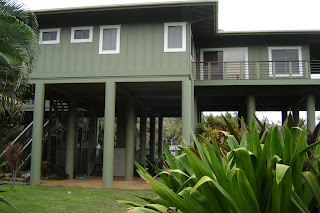


I had a premonition that Rotorua would be a Disney theme park, after Zorbing and the Agrodome Experience, but that did not turn out to be the case. Our friend Chris insisted we visit the Agrodome and we enjoyed the show. We saw 19 different breeds of sheep many of which had British names such as Dorset Horn, Leicester, and South Suffolk, a sheep shearing and a sheep dog demonstration. One dog used only his eyes to control the sheep and two others barked vociferously and ran along the backs of the sheep – poor sheep. However, it was even more fun to watch the busloads of Korean tourists. Their responses to the entertaining announcer were delayed due to the translations in their earphones. When the fellow asked if there were any Koreans in the audience, they were silent for about 20 seconds and then a collective cheer went up. Now that we are experts on New Zealand sheep, we’ll be able to identify the supposed hoards as we move to the South Island. I say supposed because actually, so far, we’ve seen very few sheep compared to the large numbers of cattle.
We stayed at an excellent bed and breakfast just outside town called The Redwoods. The Malayasian owner greeted us like old friends. She’d gone to university in Toronto and Waterloo and had very fond memories of Canada. She was most enthusiastic having done her university studies in tourism and hospitality. After 5 minutes she had all our activities planned for our short stay.
Many New Zealanders seem to have an affinity for Canada and Canadians. It seems like the relationship between New Zealand and Australia is analogous to that of Canada and the USA. Aussies like to come on holiday to NZ but don’t think much about the place otherwise. This tends to make New Zealanders a bit tetchy, as I said, similar to Canada and the US.
Rotorua was fascinating with its sulphur smell, geysers, bubbling mud pots, thermal pools etc. We visited Te Puia and Waimangu. These were very different from one another and well worth visiting. We graduated to Maori 201 this time, having had an introduction to Maori culture at Waitangi Treaty Grounds in the North. We had an evening tour with an amusing guide named Paul and cultural ambassador, Guy, (in their words) good old Maori names! Paul was hilarious and made sure we took lots of pictures - of him. Guy was really enthusiastic and obviously wanted everyone to have a good time. By the end of the tour, Paul had drilled us on the best rugby team in the world – the All Blacks. He suggested that if the British team would iron the NZ silver fern onto their jerseys, they might have a chance in the upcoming World Cup.
Apparently about 7/8 of the team members are Maori.
We were invited onto the marae (Maori meeting ground) in an elaborate ceremony. Our Hamilton friends had warned us that venturing onto the marae without an invitation could result in a spear-carrying aboriginal giving chase (just kidding, but it’s just not done). We were entertained for an hour by a very professional retinue, some of the young folks at Waitangi looked bored out of their minds during their performance, but this group seemed to really enjoy the dancing, singing and demonstrations. Claudia agreed to go onstage to learn the poi dance which involved swaying while manipulating a poi (sort of like a small tether ball) that one spins up, down and sideways in a set routine. Well you can just imagine; I was brave to agree, but being a teacher and seeing so few of the seniors, who were definitely in the majority in this group, willing to go up, I obliged. I just wanted a better look at those hunky Maori warriors, to be honest. We then ate at a hangi – or Maori feast. Maoris traditionally steam meat underground along with vegetables like pumpkin and kumara similar to the Hawaiian poi that tasted like a smoked sweet potato – interesting.
We took a 90 minute hike around Waimangu, the first half in the rain, the second in the blazing sun. Parts of the trail gave us a good sense of what the proverbial Hell must look like with foul sulphur smells, smoking caves, bubbling earth caldrons of mud etc. The colours were ochre, azure, jade,silver, ebony and several shades of burnished gold. We had a good workout, going up, down and over this fragile crusty landscape.
Next morning we took a misty hike through a cathedral of Redwoods and ancient ferns. It wasn’t hard to imagine the dinosaurs thundering through here. I enclose a picture of Duncan with the NZ silver fern.



































